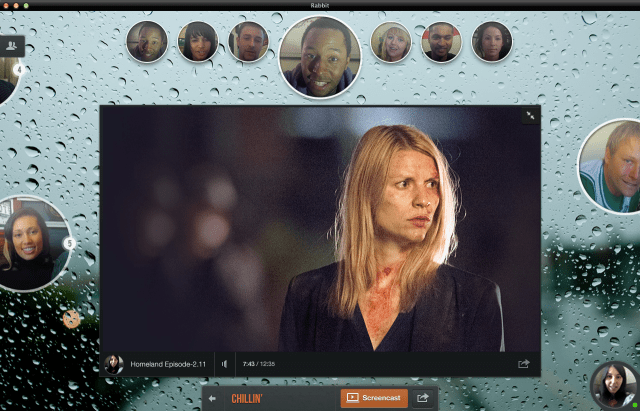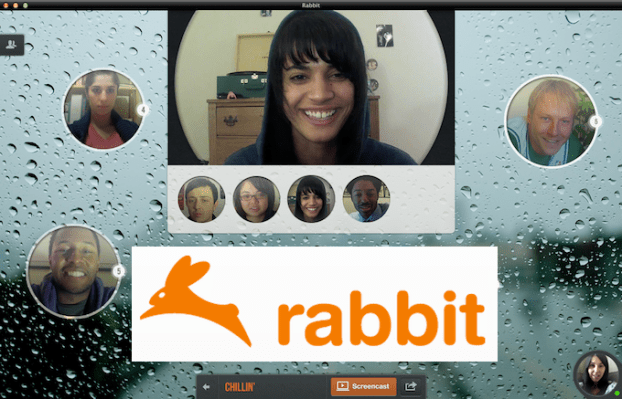Group video chat doesn’t have to feel like you’re home alone, and Rabbit comes out of stealth today to prove it. In Q1 2013 the design-focused startup will launch its desktop client where people create persistent group chat rooms, talk with friends or strangers, and watch any kind of media together. Rabbit’s always-on style could bring us together when we’d miss each other on other video chat apps.
While the closed beta of Rabbit’s OS X desktop app won’t launch for a few months, I got to take a look at it yesterday and was mighty impressed. Stephanie Morgan, a 10-year video game designer from Hands-On Mobile and ngmoco explains her and her fellow co-founders “Started with 11 different questions about emotional connection” and asked “What would you do if you were designing video chat from scratch?”
It’s certainly a crowded space with no shortage of failures. There’s top dog Google Hangouts, Airtime, Skype and Skype’s little-used Facebook integration, Video Chat Rounds, and FaceTime. But where Rabbit really differentiates itself is not relying on serendipity, or hoping two users will be surfing the service at the same time. That can cause missed connections where you log on, see none of your friends are there, and log out, only to have a friend do the same minutes later.
Instead, Rabbit is meant to be left on in the background. You create a room, name it, and select some privacy settings, and it will persist even if you’re online. Step inside, and you and your friends will see each other as soon as they fire up Rabbit. Multiple separate conversations can go on side-by-side in a room, and you can bounce from one to another just like mingling at a party. There’s no limit to how many people can be in a room or conversation, and Rabbit’s Facebook identity and messaging tie-ins means its easy to invite friends to a room.

Beyond the smart meetup functionality, Rabbit’s design really shines. Morgan, Gregory Fischbach the founder and CEO of Mortal Kombat-maker Acclaim Entertainment, and the team ditched the cold chat boxes. Instead fellow chatters show up in little circles. Morgan explains “one thing that makes people disconnected on video chat is that you see the background [behind where people are on their webcams because of the square chat windows]. That shows you’re in different locations.” Rabbit’ circular chat windows naturally crop around people’s heads so you all feel like you’re actually in the same place.
Instead of a massive window showing your reflection on screen that makes people self-conscious and distracts them from the conversation, you only see yourself in a tiny circle in the bottom right. That gives more room to show who you’re chatting with. Similar to Hangouts, whoever is currently talking gets switched into the primary screen. But Rabbit wins by placing that window directly beneath your webcam in the top center of the screen. This way it feels like you’re making eye contact.
Since Rabbit runs as a desktop application, it gets deep OS-level access to what else you’re doing on your computer. That means you can instantly show your conversation partners a photo, video, spreadsheet, or any other app or file. Alternatively you may pipe in video from services like YouTube or Hulu. Rabbit also gives each room some background chatter noise, so it sounds like you’re in the corner of a living room full of friends. It’s a lot more comfortable than a base of ominous dead silence like on most video chat apps.
Rabbit’s also designed to let you keep computing while you chat. Open your web browser or another app, and the entire Rabbit chrome disappears and you’ll just see the floating heads of your chat partners overlaid on your screen. This makes it a great way to spend time together while you’re online without necessarily having to full engage in conversation.
Since Rabbit will need critical mass to really be sticky, it will be fascinating to see if it can gain traction in the new year and take off where Airtime fell flat. All this fancy design won’t matter if it can’t convince people to download the software and turn it on. If it does there’s plenty of monetization opportunities from display ads to premium features. But for now I’m excited to see a group of founders bring a fresh approach to faux in-person communication. There’s no need to feel like you’re by yourself online any more.
You can sign-up now to get access when Rabbit becomes available.
